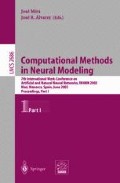Abstract
Visual deficits have been discovered in sufferers of Parkinson’ disease [1] and the cause of this is not clearly understood. This paper reports on a digital neuromodel that investigates a hypothesis that the deficit may be due to a projection from the Basal Ganglia to the Superior Colliculus where a shortage of Dopamine introduces noise in the oculo-motor loop. New experiments were done with Parkinson’s patients to track the deficit and the neuromodel predicts performance against oculo-motor noise. It is seen that a group Parkinson’s sufferers in whom the deficit is pronounced follow the predicted law, while controls with poor performance do not follow the law. This helps to uphold the noise hypothesis.
Access this chapter
Tax calculation will be finalised at checkout
Purchases are for personal use only
Preview
Unable to display preview. Download preview PDF.
References
Hodgson TL, Bajwa A, Owen AM, Kennard C: Cognitive Neuroscience. 12, 5, 894–907, 2000
Aleksander, I., Dunmall, B., Del Frate, V., Neurocomputational Models of Visualisation: A preliminary report, Proc. IWANN 99, Alicante-Spain (1999)
Aleksander, I., Dunmall, B., Seeing is Believing. Proc. IWANN 99, Granada-Spain (2001)
Aleksander, I. and Dunmall, B.: An extention to the hypothesis of the asynchrony of visual consciousness. Proc R Soc Lond B 267, (2000) 197–200
Lockwood, G., and Aleksander, I., Predicting the behaviour of G-RAM Networks. Neural Networks, Volume 16, Issue 1, January 2003, Pages 91–100
Galletti, C. and Battaglini, P. P., Gaze-Dependent Visual Neurons in Area V3A of Monkey Prestriate Cortex. Journal of Neuroscience, 6, (1989), 1112–1125
Author information
Authors and Affiliations
Editor information
Editors and Affiliations
Rights and permissions
Copyright information
© 2003 Springer-Verlag Berlin Heidelberg
About this paper
Cite this paper
Aleksander, I., Morton, H. (2003). A Digital Neural Model of Visual Deficits in Parkinson’s Disease. In: Mira, J., Álvarez, J.R. (eds) Computational Methods in Neural Modeling. IWANN 2003. Lecture Notes in Computer Science, vol 2686. Springer, Berlin, Heidelberg. https://doi.org/10.1007/3-540-44868-3_12
Download citation
DOI: https://doi.org/10.1007/3-540-44868-3_12
Published:
Publisher Name: Springer, Berlin, Heidelberg
Print ISBN: 978-3-540-40210-7
Online ISBN: 978-3-540-44868-6
eBook Packages: Springer Book Archive

